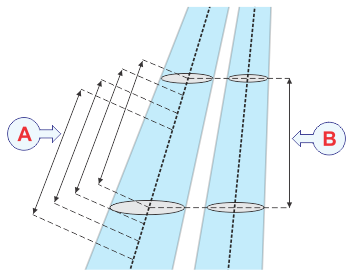Depth cells
In water current measurements, the phrase cell is used to describe a depth cell. These are uniform segments used by the acoustic Doppler current profiler (ADCP) to measure the velocity of the current.
The acoustic Doppler current profiler (ADCP) measures the speed and direction of the water current by means of acoustic pulses. These pulses have duration decided by the current size of the depth cell. Each beam can be seen as a number of depth cells evenly placed from the transducer surface and down to the lower end of the
acoustic beam.
The size of the depth cells can be adjusted in the Normal Operation dialog box.
| • | Use smaller depth cells in shallower waters. |
| • | Use larger depth cells in deeper waters. |
A small depth cell offers better range resolution. This makes it is easier to detect minor depth variations in the current velocity. On deeper waters, a small depth cell will gradually suffer from more and more noise. The ping rate will also be reduced due to the high amount of processing that is required. A larger depth cell tolerates more noise. For this reason, larger depth cells must be used to measure velocity in deep waters.

| A | The ranges covered by succeeding depth cells are overlapping. |
| B | Depth cell size |
To make the measurements, the EK80 creates depth cells along the beam. The vertical size of each depth cell is defined by the Depth Cell Size setting. The ranges covered by succeeding depth cells are overlapping. You can regard the depth cells as different "snap shots" of one cell sliding along the beam. The backscatter data from each depth cell is used to measure the velocity within that depth cell.
This "sliding cell method" offers smoother velocity results in the ADCP views. By processing the echo data from the entire beam, the EK80 is able to present an accurate velocity profile of the column covered by the beam.